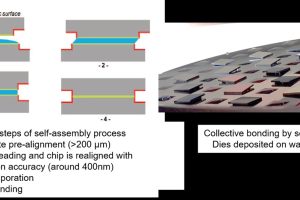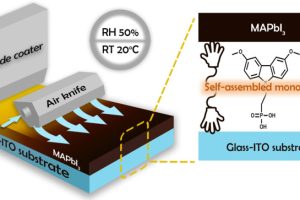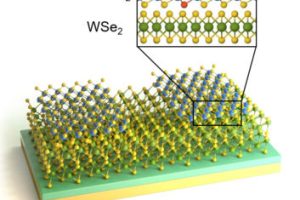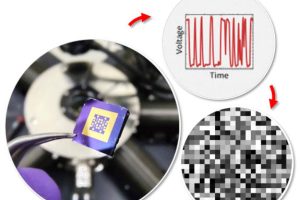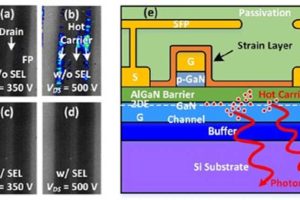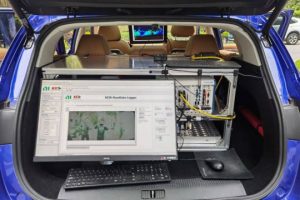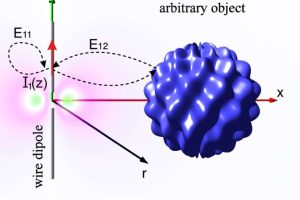Intel and CEA-Leti have optimised a hybrid direct-bonding, self-assembly process for D2W (Die-to-Wafer) bonding that has the potential to increase the alignment accuracy as well as fabrication throughput by several thousand dies per hour. The approach uses capillary forces of a water droplet to align dies on a target wafer. While the D2W hybrid bonding process is seen as being ...
Research
The latest electronics research news from within the industry and universities from around the world.
Another step on the road to perovskite solar mass production
Large-areas of perovskite solar cell active layer can be stuck to glass using self-assembling organic mono-layers, according to scientists in China, who see it as a route to commercialisation of this promising photovoltaic technology. PTAA – poly[bis(4-phenyl)(2, 4, 6-trimethylphenyl)amine] – is a successful hole-transporting material for perovskite solar cells, but can only be applied using spin-coating, which is not suitable ...
Imec looks to reduce chip industry’s carbon footprint
Imec’s Sustainable Semiconductor Technologies and Systems (SSTS) research program is bringing together stakeholders of the semiconductor value chain, from large system companies such as Apple and Microsoft, to suppliers, including ASM, ASML, KURITA, SCREEN and Tokyo Electron. The program was set up last year as part of imec’s sustainability efforts to support the semiconductor industry reducing its carbon footprint. The addition ...
p-type 2D transistors mean atomically-thin CMOS is not far away
Van der Waals metal contacts could be the key to CMOS made from thin-film 2D semiconductors, according to the Korea Institute of Science and Technology (KIST), which has made contacts from chlorine-doped tin diselenide. “It was difficult to implement complementary logic circuits with conventional two-dimensional semiconductor devices because they only exhibit the characteristics of either n-type or p-type devices due to ...
Electrons mined for true random numbers
Scientists in India have created random numbers from a 2-d material heterostructure that pass US NIST (National Institute of standards and Technology) SP 800-90B and SP 800-22 testing. It is “an all-electronic van der Waals heterostructure-based device capable of detecting discrete charge fluctuations for extracting entropy from physical processes, according to the researchers in the paper ‘A high-quality entropy source ...
Robot crab the size of a flea
Researchers from Northwestern University have created a robot crab which can bend, twist, walk, turn, crawl and jump and is 0.02 inches wide. The robot was inspired by peekytoe crabs. ‘Robotics is an exciting field of research, and the development of microscale robots is a fun topic for academic exploration,’ says Professor John Rogers the project leader. The robotic crab ...
Imec driving electronic/photonic comms IC development
Researchers at imec are developing high-speed electronic and photonic integrated circuits for 100 to 130Gbaud transceivers, both for intensity-modulated direct-detect (IMDD) and for coherent optical transceivers. For a coherent transceiver, the specifications and functionality for the optics and electronics are much more demanding. The receiver DSP is also significantly more complex (compared to IMDD). Scheme of an optoelectronic transceiver For ...
ISPSD: Hot carrier injection erodes GaN Rds(on)
GaN transistor maker Innoscience Technology is disclosing research on 650V device reliability at the IEEE International Symposium on Power Semiconductor Devices (ISPSD) in Vancouver this week. The company is fabricating GaN-on-Si HEMTs on a 200mm CMOS-compatible process, for a power factor correction (PFC) boost converter application. Hard switching test Vds=600V Vgs=6V 100kHz According to the company, it’s ‘strain enhancement layer’ technology ...
National instruments launches ADAS data gathering fleet
National Instruments has announced a fleet of vehicles for Europe, the US and China that will record data for autonomous driving research. The intention is to provide data for training, testing and validating perception algorithms and hardware. “ADAS data recording is one of the most complex challenges, as data from multiple sensor modalities – camera, radar, lidar, ultrasonics, infrared, IMUs, ...
BT trials excited atoms antenna technology
BT today announced a pioneering trial of a new hyper-sensitive quantum antenna technology using excited atomic states that could boost the capability of next generation 5G and IoT networks. Atomic Radio Frequency (RF) receiver technology represents a revolutionary new way of detecting radio waves that could find much weaker signals than conventional receivers. The receiver works by using a quantum ...
 Electronics Weekly Electronics Design & Components Tech News
Electronics Weekly Electronics Design & Components Tech News
